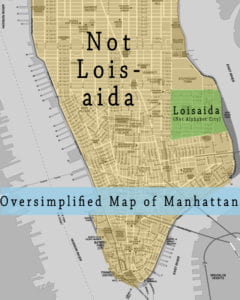
Graphic by author based on “You Are Here” by Maria Popova
The term “Loisaida” was first recorded by Bimbo Rivas in an unpublished 1974 bilingual poem. “En mi mente, mi amada,/ yo te llamo Loisaida/ Increible/ una mezcla, la perfecta,” he writes. (English: In my mind, beloved,/ I call you Loisaida./ Incredible/ a mix, the perfect one.)
Rivas continues the poem by demonstrating a quixotic love for the neighborhood despite the physical state of decay he experienced. He writes, “Your buildings are/ burning up/ that we got to stop./ Loisaida, my love,/ Te amo.” (English: I love you.)
In Loisaida as Urban Laboratory (University of Georgia Press, 2020), Timo Schrader follows Rivas’ thread and records the history of the neighborhood through the lens of the neighborhood’s heritage of Puerto Rican grassroots activism from 1950-2000.
Although Schrader explains that the physical boundaries of the neighborhood run loosely from East Houston street to East 14th Street and from 1st Avenue to the East River, Schrader emphasizes that the bilingual name of the place is really emblematic of the attitude of the community.
“The term ‘Loisaida’ is not so much a label for a physical area as it is a state of mind,” Schrader writes.
Throughout Loisaida as Urban Laboratory, Schrader emphasizes this utopic spirit embodied by Rivas was central to the imagination of the neighborhood, and pointed out that staying to improve the neighborhood despite the abandoned buildings was central to the founding mythos of the geocultural space of Loisaida.
However, that historical vision of Loisaida contrasts sharply with the more gentrifying label ‘Alphabet City’ leftover from the real estate push of the late 1980’s. Unlike the working-class neighborhood of Loisaida, Alphabet City was envisioned as the reclaimed home of the artistic avant-garde. Describing the contrast between Loisaida and Alphabet City, Lisa Foderaro writes in May 1987 New York Times article,
“The contrasts and juxtapositions in this outlying region – just west of the Franklin D. Roosevelt Drive and the East River – are startling. In one lot, off Avenue D, roosters, ducks and chickens wander about in front of a tiny wooden house. And nearby, in the middle of a sidewalk, a woman fries fritters and chicken breasts in a large skillet, peddling a modest serving for 50 cents. But only two blocks north, also off Avenue D, is Mokotoff Galleries, a sleek space with abstract paintings, colorful and childlike, that are priced as high as $20,000.”
Despite the wave of gentrification in the early 2000’s that spelled out the eventual demise of Alphabet City, Loisaida itself is not yet entirely erased. Taking inspiration from he interactive LES Healthy community map, the Loisaida center is in the process of applying to a grant from New York State Energy Research and Development Authority (NYSERDA).
[googlemaps https://www.google.com/maps/d/embed?mid=1tvvH8KbFt53X0a5QNX2nUm79uSYEM-F2&w=640&h=480]
The point of the grant is to invest in Ecolibrium, a program that aims to increase environmental literacy in the neighborhood by equipping and training a cohort of citizen-scientists to measure the grade of pollution, said Paul Garrin, the Creative Technologist & IT Manager at the Loisaida Center.
Even though the project is still in the planning phase, in true Bimbo Rivas fashion, Ecolibrium is as bilingual (from the Greek οικος, meaning home) and utopic as the term Loisaida itself.

Great post! I like the way you’ve interpreted a mapping exercise to be broader than geographic in scope. With neighborhood boundaries and names this seems particularly appropriate given their fluidity, and as you point out the term Loisaida is certainly broader than a mere place name. I also think you’ve made a great link with name of the new Ecolibrium project.